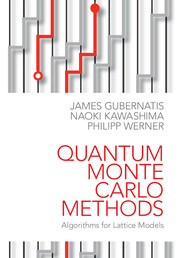Book contents
- Frontmatter
- Contents
- Preface
- Part I Monte Carlo basics
- Part II Finite temperature
- Part III Zero temperature
- 9 Variational Monte Carlo
- 10 Power methods
- 11 Fermion ground state methods
- Part IV Other topics
- Appendix A Alias method
- Appendix B Rejection method
- Appendix C Extended-ensemble methods
- Appendix D Loop/cluster algorithms: SU(N) model
- Appendix E Long-range interactions
- Appendix F Thouless's theorem
- Appendix G Hubbard-Stratonovich transformations
- Appendix H Multi-electron propagator
- Appendix I Zero temperature determinant method
- Appendix J Anderson impurity model: chain representation
- Appendix K Anderson impurity model: action formulation
- Appendix L Continuous-time auxiliary-field algorithm
- Appendix M Continuous-time determinant algorithm
- Appendix N Correlated sampling
- Appendix O The Bryan algorithm
- References
- Index
10 - Power methods
from Part III - Zero temperature
Published online by Cambridge University Press: 05 May 2016
- Frontmatter
- Contents
- Preface
- Part I Monte Carlo basics
- Part II Finite temperature
- Part III Zero temperature
- 9 Variational Monte Carlo
- 10 Power methods
- 11 Fermion ground state methods
- Part IV Other topics
- Appendix A Alias method
- Appendix B Rejection method
- Appendix C Extended-ensemble methods
- Appendix D Loop/cluster algorithms: SU(N) model
- Appendix E Long-range interactions
- Appendix F Thouless's theorem
- Appendix G Hubbard-Stratonovich transformations
- Appendix H Multi-electron propagator
- Appendix I Zero temperature determinant method
- Appendix J Anderson impurity model: chain representation
- Appendix K Anderson impurity model: action formulation
- Appendix L Continuous-time auxiliary-field algorithm
- Appendix M Continuous-time determinant algorithm
- Appendix N Correlated sampling
- Appendix O The Bryan algorithm
- References
- Index
Summary
Quantum Monte Carlo versions of the power method for finding ground states come with different names, including the projector method, diffusion Monte Carlo, and Green's function Monte Carlo. These quantum Monte Carlo methods are primarily adoptions of methods developed for classical problems. We summarize the basics of deterministic power methods, detail key features of Monte Carlo power methods, and put these concepts into the context of quantum ground state calculations. We conclude the chapter by outlining power methods that allow the computation of a few excited states. In the computation of excited states, we encounter sign problems, which are discussed inmore detail in Chapter 11. Themethods and techniques of the present chapter are very general and most usefully applied to systems of Bosons and to systems of Fermions and quantum spins that do not suffer from a sign problem.
Deterministic direct and inverse power methods
The power method is over a century old. As a deterministic method, it originally was combined with the deflation technique (Meyer, 2000; Stewart, 2001b) as a method to compute all the eigenvalues and eigenvectors of small matrices. Today, its deterministic use is limited primarily to special applications involving very large, sparse matrices. Many of these applications are in the study of quantum lattice models as the corresponding Hamiltonian matrices are typically very sparse. In these applications, we can perhaps initially store in computer memory the relatively small number of nonzero matrix elements and all the vectors. Soon, because of what is undoubtedly the now familiar exponentially increasing number of basis states that determines the order of the Hamiltonian matrix and hence the size of our vectors, we reach the point where computer memory restrictions allow us to store only a few vectors and we need to compute the matrix elements on the fly. When we have problems for which we cannot even store all the components of one vector, the power method's expression as a Monte Carlo procedure is our only option. With it, we can compute a few of the extremal eigenvalues, that is, a few of the largest or smallest eigenvalues.
The mathematical basis for the method is simple.
- Type
- Chapter
- Information
- Quantum Monte Carlo MethodsAlgorithms for Lattice Models, pp. 302 - 337Publisher: Cambridge University PressPrint publication year: 2016

